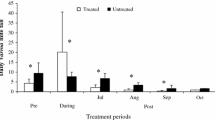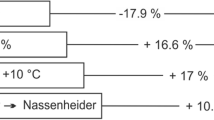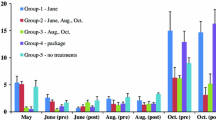Abstract
In 2 experiments bee colonies in southern France were treated with conidia of a Beauveria bassiana isolate collected from Varroa mites in the region. Objectives were to evaluate treatment effect on colony weight, adult bee mass, and capped brood and honey, and on Varroa fall onto sticky boards. Treatments included conidia formulated with either wax powder or wheat flour, flour alone, or control. Treatment did not affect colony health. Colonies treated with conidia and wax powder had higher mite fall compared to controls while those treated with conidia and wheat flour did not. The proportion fallen, infected mites in both conidia treatments was higher than controls for up to a week. Higher mite fall and infection rates were observed in treated hives in the 2nd, smaller experiment. The relationships between dosage and proportion fallen, infected mites, and between ambient temperature and infection duration, were examined. Future experiments will explore Varroa control using conidia.
Zusammenfassung
In zwei Experimenten wurden Honigbienenvölker in Südfrankreich mit Konidiensporen eines aus Varroamilben der Region gesammelten Isolates behandelt. Ziel war die Erfassung der Auswirkung der Behandlung auf das Gewicht der Völker, das Gesamtgewicht an adulten Bienen, auf die verdeckelte Brut und auf die Honigmenge, sowie auf den Totenfall von Varroamilben auf klebrige Bodeneinlagen. Die Behandlungen umfassten Formulierungen von Konidiensporen entweder mit Wachspulver oder mit Weizenmehl, sowie Weizenmehl alleine und unbehandelte Kontrollvölker. Die Behandlungen hatten keinen Einfluss auf die Gesundheit der Bienenvölker. Die mit Konidiensporen und Wachspulver behandelten Völker hatten einen höheren Milbentotenfall als die Kontrollvölker, bei den mit Konidiensporen und Weizenmehl behandelten Völkern war dies nicht der Fall. Der Anteil an infizierten Milben im Totenfall war bei beiden Behandlungen mit Konidiensporen über den Zeitraum von etwa einer Woche höher als bei den Kontrollen. Ein erhöhter Milbentotenfall und erhöhte Infektionsraten wurden auch in dem zweiten, kleineren Experiment gefunden. Die Beziehung zwischen der Dosierung und dem Anteil infizierter Milben im Totenfall und zwischen der Umgebungstemperatur und der Infektionsdauer wurden untersucht. Zukünftige Experimente sollen die Möglichkeit einer Behandlung der Varroose mittels Konidiensporen untersuchen.
Similar content being viewed by others
References
Branco M.R., Kidd N.A.C., Pickard R.S. (2006) A comparative evaluation of sampling methods for Varroa destructor (Acari: Varroidae) population estimation, Apidologie 37, 1–10.
Burges H.D. (1998) Chapter 4. Formulation of mycoinsecticides, in: Burges H.D. (Ed.), Formulation of microbial biopesticides: Beneficial microorganisms, nematodes and seed treatments, Kluwer Academic Publishers, Dordrecht, The Netherlands, pp. 131–185.
Chandler D., Sunderland K.D., Ball B.V., Davidson G. (2001) Prospective biological control agents for Varroa destructor n. sp., an important pest of the European honey bee, Apis mellifera, Biocontrol Sci. Technol. 11, 429–448.
Cherry A., Jenkins N., Heviefo G., Bateman R.P., Lomer C. (1999) A West African pilot scale production plant for aerial conidia of Metarhizium sp. for use as a mycoinsecticide against locusts and grasshoppers, Biocontrol Sci. Technol. 9, 35–51.
Davidson G., Phelps K., Sunderland K.D., Pell J.K., Ball B.V., Shaw K.E., Chandler D. (2003) Study of temperature-growth interactions of entomopathogenic fungi with potential for control of Varroa destructor (Acari: Mesostigmata) using a nonlinear model of poikilotherm development, J. Appl. Microbiol. 94, 816–825.
Fakhimzadeh K. (2001) Effectiveness of confectioner sugar dusting to knock down Varroa destructor from adult honey bees in laboratory trials, Apidologie 32, 139–148.
Fargues J., Maniania N.K., Delmas J.C., Smits N. (1992) Influence de la temperature sur la croissance in vitro d’hyphomycetes entomopathogenes, Agronomie 12, 557–564.
Goettel M.S., Inglis G.D. (1997) Fungi: Hyphomycetes, in: Lacey L. (Ed.), Manual of techniques in insect pathology, Academic Press, San Diego, CA, USA, pp. 213–249.
Hong T.D., Gunn J., Ellis R.H., Jenkins N.E., Moore D. (2001) The effect of storage enviroment on the longevity of conidia of B. bassiana, Mycol. Res. 105, 597–602.
Hong T.D., Ellis R.H., Gunn J., Moore D. (2002) Relative humidity, temperature, and the equilibrium moisture content of conidia of Beauveria bassiana (Balsamo) Vuillemin: a quantitative approach, J. Stored Prod. Res. 38, 33–41.
James R.R., Hayes G., Leland J.E. (2006) Field trials on the microbial control of varroa with the fungus Metarhizium anisopliae, Am. Bee J. 146, 968–972.
Jaronski S.T., Goettel M.A., Lomer C. (2004) Chapter 12. Regulatory requirements for ecotoxicological assessments of microbial insecticides — how relevant are they? in: Hokkanen H., Hajek A. (Eds.), Environmental impacts of microbial insecticides: Need and methods for risk assessment, Kluwer Academic Publishers, Dordrecht, The Netherlands, pp. 237–260.
Jones K.A., Burges H.D. (1998) Chapter 2. Technology of formulation and application, in: Burges H.D. (Ed.), Formulation of microbial biopesticides: Beneficial microorganisms, nematodes and seed treatments, Kluwer Academic Publishers, Dordrecht, The Netherlands, pp. 7–30.
Kanga L.H.B., Jones W.A., James R.R. (2003) Field trials using the fungal pathogen, Metarhizium anisopliae (Deuteromycetes: Hyphomycetes) to control the ectoparasitic mite, Varroa destructor (Acari: Varroidae) in honey bee, Apis mellifera (Hymenoptera: Apidae) colonies, J. Econ. Entomol. 96, 1091–1099.
Kanga L.H.B., Jones W.A., Garcia C. (2006) Efficacy of strips coated with Metarhizium anisopliae for control of Varroa destructor (Acari: Varroaidae) in honey bee colonies in Texas and Florida, Exp. Appl. Acarol. 40, 249–258.
Littell R.C., Milliken G.A., Stroup W.W., Wolfinger R.D. (1996) SAS system for mixed models, SAS Institute, Cary, NC, USA.
Lomer C.J., Prior C., Kooyman C. (1997) Development of Metarhizium spp. for the control of locusts and grasshoppers, Mem. Entomol. Soc. Canada 171, 265–286.
Macedo P.A., Wu J., Ellis M.D. (2002) Using inert dusts to detect and assess varroa infestations in honey bee colonies, J. Apic. Res. 41, 3–7.
Martin S. (1998) A population model for the ectoparasitic mite Varroa jacobsoni in honey bee (Apis mellifera) colonies, Ecol. Model. 109, 267–281.
Martin S.J. (2001) The role of Varroa and viral pathogens in the collapse of honey bee colonies: a modelling approach, J. Appl. Ecol. 38, 1082–1093.
Meikle W.G., Jaronski S., Mercadier G., Quimby P.C. (2003) A distributed delay routine-based simulation model of Beauveria bassiana conidial stability in response to environmental stressors, BioControl 48, 561–578.
Meikle W.G., Mercadier G., Girod V., Derouané F. (2006) Evaluation of Beauveria bassiana (Balsamo) Vuillemin (Deuteromycota: Hyphomycetes) strains isolated from varroa mites in southern France, J. Apic. Res. 45, 219–220.
Meikle W.G., Mercadier G., Holst N., Nansen C., Girod V. (2007) Duration and spread of an entomopathogenic fungus, Beauveria bassiana (Balsamo) Viullemin (Deuteromycota: Hyphomycetes), used to treat varroa mites, Varroa destructor Anderson and Trueman (Acari: Varroidae), in honeybee colonies, J. Econ. Entomol. 100, 1–10.
Rinderer T.E., de Guzman L.I., Delatte G.T., Stelzer J.A., Lancaster V.A., Kuznetsov V., Beaman L., Watts R., Harris, J.W. (2001) Resistance to the parasitic mite Varroa destructor in honey bees from far-eastern Russia, Apidologie 32, 381–394.
Rückhold S., Grobecker K.H., Isengard H.D. (2001) The effects of drying on biological matrices and the consequences for reference materials, Food Control 12, 401–407.
Savary F. (2006) Le conservatoire de l’abeille noire provençale, Bull. Tech. Apic. 32, 115–120.
Shaw K.E., Davidson G., Clark S.J., Ball B.V., Pell J.K., Chandler D., Sunderland K.D. (2002) Laboratory bioassays to assess the pathogenicity of mitosporic fungi to Varroa destructor (Acari: Mesostigmata), an ectoparasitic mite of the honeybee, Apis mellifera, Biol. Control 24, 266–276.
Simpson J. (1961) Nest climate regulation in honey bee colonies, Science 33, 1327–1333.
Southwick E.E. (1991) The colony as a thermoregulating superorganisms, in: Goodman L.J., Fisher R.C. (Eds.), The behavior and physiology of bees, CAB Int., pp. 28–47.
Tanada Y., Kaya H.K. (1993) Insect Pathology, Academic Press, San Diego, CA, USA.
Winston M.L. (1987) The biology of the honey bee, Harvard Univ. Press, Cambridge, MA, USA.
Author information
Authors and Affiliations
Corresponding author
Additional information
Manuscript editor: Marla Spivak
Rights and permissions
About this article
Cite this article
Meikle, W.G., Mercadier, G., Holst, N. et al. Impact of a treatment of Beauveria bassiana (Deuteromycota: Hyphomycetes) on honeybee (Apis mellifera) colony health and on Varroa destructor mites (Acari: Varroidae). Apidologie 39, 247–259 (2008). https://doi.org/10.1051/apido:2007057
Received:
Revised:
Accepted:
Issue Date:
DOI: https://doi.org/10.1051/apido:2007057




